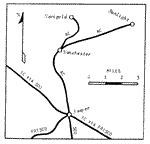History The following history is a re-print of an inset in an article written by Thomas Lawson, Jr., an Alabaman studying at the University of Tennessee—and a keen student of the iron horse, particularly Southern short-line and industrial steam--has worked summers as an engine man on two Dixie daisy-picker lines. The article "The Last Days of the Alabama Central" also appears on this web site at the Last Days link above, as published in the periodical "Steam Locomotive & Railroad Tradition" Number 17-18 February 1967. The Alabama Central Railroad was built in 1906-07, apparently as part of a personal in-vestment by a scion of AT&T, Enos M. Barton of Chicago , who was president and chairman of the board of the Western Electric Company. Although its charter provided for a line from Tuscaloosa to Decatur, about 100 miles, the northwestern Alabama carrier ran only from outside connections at Jasper to Barton's lumber mill at Manchester , 6.7 miles. In 1912, four years before his death, Barton sold the mill and local timberlands to Manchester Saw Mills, but Although the Alabama Central appears to have done well financially during its earliest years, it lost money rather consistently later on, despite the combined revenues from coal and lumber. When the lumber company announced in 1926 that it was about to cease operations, the railroad applied for abandonment. I. O. Drewry Contracting Company, which owned the Sunlight mine, bought the Manchester - Sunlight extension from the lumber company and tried to stop the Central from abandoning after the Barton Estate turned down Drewry's offer for the road. In January, 1927, the I.C.C. approved abandonment, with a conditional sale proviso; eventually a purchase agreement was reached between the Barton interests and the coal operators and the line was kept running. A casualty of these times was the passenger business, never brisk—there had been just 16 riders in all of 1925. In the beginning, though, the Central carried more than 3,000 passengers annually and ran two scheduled round trips a day; this was reduced to one trip during World War I and to non-scheduled "irregular service" not long after. With the change in fortunes and management also went the road's only new locomotive, 2-6-2 No. 2, to be replaced by two used 4-6-0's. (The only times when there were as many as two locomotives on the roster were during World War I, for a few years around 1930, and after 1954. At other times an Illinois Central steamer was borrowed while that road performed heavy repairs on the short line ' s only engine.)
|


